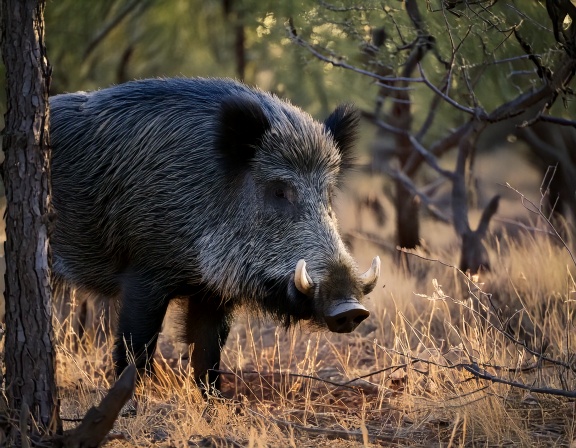My wife, Amy, and I decided to convert some heavily wooded and creek-cut acreage into an ecological haven of renewed tallgrass prairie and protected species habitat. Serious about our goals, we took classes from the Texas A&M AgriLife Extension Service. We learned about Blackland prairie botany and biology, erosion control, and best practices for farm and woodland management. And feral pigs.
The featured image was generated by Scooter Smith using Adobe Firefly.
My wife, Amy, and I decided to convert some heavily wooded and creek-cut acreage into an ecological haven of renewed tallgrass prairie and protected species habitat. In the years we spent out there, coming in contact with wild pigs, one way or another, became an almost casual event.
When we stumbled onto a lone male expelled from the herd, we had an informal agreement: we would all be startled and go on with our business. If a hog snorted with menace from the darkness of the underbrush, we would do our best to avoid what could possibly be a fair-sized sounder. When boars savagely fought for control of a herd at night, we certainly did not check it out, no matter how close to the house.
It was a simple system that usually worked, although eventually, our Blue Heeler, Dotty, would complicate matters. With enthusiasm.
Our days at the ranch were often filled with significant projects like clearing land, fencing, plowing, planting, and cutting brush. Most were rife with the repair of fences, barns, tanks, and equipment.
If you didn’t already know, working a ranch meant almost endlessly fixing things plus fixing the tools needed to fix things. Therefore, we dropped off to sleep with contradictory feelings; a justified pride of accomplishment, and a little existential dread, knowing we would never really get caught up.
Nevertheless, Amy and I made it a point to enjoy the land from time to time. We investigated the local geology and observed the ways of beavers, coyotes, herons, and snakes. We honed our tracking and plant identification skills. On clear nights, we basked in the glittering infinity of night skies.
Serious about our goals, though, we took classes from the Texas A&M AgriLife Extension Service. We learned about Blackland prairie botany and biology, erosion control, and best practices for farm and woodland management.
They had a lot to say about feral pigs, too.
While we were taking these courses, from 2004 through 2008, wild hogs were causing an estimated $52 million worth of damage per year in Texas. At that time they numbered more than 2-and-half million, putting the bulk of the country’s feral pig population in one state.
Their ancestors, Eurasian wild boars, were introduced to the Americas in 1539 by Hernando de Soto. As his expedition wandered through the South from Florida to Texas, enough of his pigs escaped into the wild to build a stable population. Over the ensuing centuries, many domesticated swine also went feral. They quickly reverted from their dappled pink look to the spiny black-haired, large-tusked appearance of the Old World boars. They interbred easily and profusely, with the domestics adding their bred weight and mass to the wild population.
Reaching sexual maturity at around six months, sows produced about two litters of five or six viable piglets per year for an average of seven years. By 2019, the feral pig population in the U.S. had grown to an estimated seven million.
As sounders, pig herds, aged and enlarged, they became female dominant. Although protected by a large breeding male who fought for his position, the females made up most of the pack hierarchy. Since their tusks also grew long and sharp, they took it upon themselves to fiercely protect the herd’s nursery of piglets and young hogs.
Fiercely.
